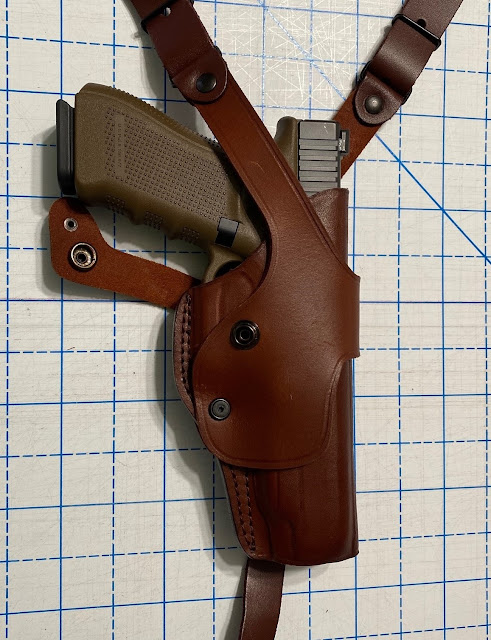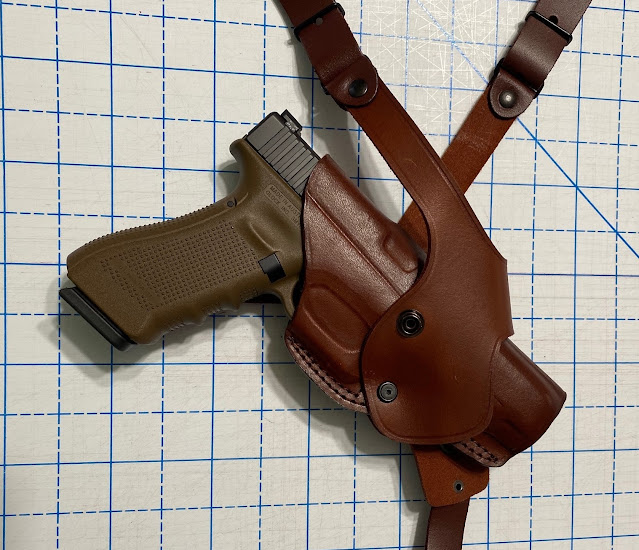 |
| The Roto Shoulder Holster laid out as you might wear it. Craft Holster has photographs of a model wearing the holster so you can get a better idea of how it looks on a person. |
Note: I received this holster from Craft Holsters at no charge so that I could do a review, but have received no monetary compensation and I have retained full editorial control.
Craft Holsters has been very kind in providing a few holsters for me to review this year. In this article, I am reviewing the Vertical Roto Shoulder Holster With Double Magazine Pouch offered through Craft Holsters for $165. The holster is manufactured by Falco which is a reputable leather holster manufacturer. [Update: I ordered the Roto holster for a Glock 34, but Craft Holsters offers other choices for the Glock 34 as well. And, of course, the Roto holster is offered for many other models of handguns].
First I will discuss the why of a vertical shoulder holster, and then move on to cover the features of the holster, as well address the manufacturing quality. Then I will address my experience with the holster.
With so many quality horizontal shoulder holsters available, what purpose does a vertical shoulder holster serve? Basically, it has to do with the size of the handgun, particularly barrel length. A horizontal should holster works well so long as the barrel and/or grip do not extend so far as to push out the cover garment further than how it naturally drapes over the body. Even if concealed carry was not an issue, you still don't want the barrel or grip sticking out so far as to easily get caught on things or interfere with your movement. Thus, horizontal shoulder holsters have a limit as to the size of weapon that can be carried.
My own experience with a horizontal shoulder holster is with the Beretta 84--large for a .380, but compact sized compared to most other pistols. My son uses a Glock 26 in a shoulder holster. Both firearms are easily concealed with that set-up when using a loose-fitting cover garment such as an unbuttoned sports jacket, a loose and unbuttoned shirt, or similar. And a bulky winter coat, zipped up, would easily conceal such a set up. I would expect that the same would hold true with other compact pistols such as the Glock 19.
But when you get up to full-sized duty handguns, or larger, you may cross into a point where it will no longer conceal very well using a horizontal holster. An example might be a 6-inch barrel revolver, a full-sized 1911, or, as in my case, a Glock 34. I would like to carry my Glock 34 concealed, but with a full-sized Glock 17 frame and a longer slide due to the 5.31-inch barrel, it just is not very feasible for me to do so, even using OWB holsters. (And I mean real concealment, not just a cover garment that meets the requirements under IDPA rules).
That's where the vertical shoulder holster comes into play. By running the slide/barrel along the torso, instead of perpendicular to the torso, you can conceal much longer barreled weapons than you can with a standard horizontal shoulder holster. Which is good for me, because as much as I like my Beretta 84, I really would like to carry something larger and more powerful for the winter months when I might be faced with someone wearing heavy winter clothing. And since, in the depths of winter, I will be arriving at work about sunrise and leaving after sunset, I like the idea of having a carry gun with illuminated tritium night sights.
 |
| Front of Holster. Each square is one-inch. |
 |
| Back of holster |
As you can see from the two photographs above, the roto holster has a vertical holster on one side and is counterbalanced by a double-magazine pouch on the other. It also comes with two "tie-downs" to keep the holster from flopping around and to provide some resistance for when you are trying to draw the weapon out of the holster. Which is pretty important in my case because, even after using leather softeners to stretch the leather, the fit is still pretty tight on my pistol. Without the tie down, I expect that I could end up pulling the holster out quite a ways before the handgun comes loose. I'm sure that will go away with use, but for right now, I use both the tie downs.
The straps on the harness have holes to adjust the length of the straps. Rather than buckles, it uses screws that can be removed and replaced, which makes it easier to adjust than the method used on my shoulder holster for my .380.
 |
| Strong-side tie down |
The tie down attached to the holster is shown above. As you can see, the strap is leather. There are three snaps on the strap that can be snapped onto the back of the holster. I've snapped a couple at the same time, but the snaps are strong enough that you actually only need to have one snapped in place. But this gives you quite a bit of adjustment so that you can fit it around your belt.
The tie down for the magazine pouch uses a single pair of snaps, but the strap is nylon and is adjustable for length using the strap adjuster.
The straps meet and are held together by a leather yoke, pictured above. The yoke is two pieces of leather with the strap ends sandwiched between them and fixed in place with rivets. This still allows some movement of the straps, but does not have the free play that my other shoulder has by virtue of it using snaps. On the other hand, this one doesn't tend to get the straps twisted or tangled because the straps don't have the same freedom of motion. So, a bit of a trade-off there.
Of course, being a vertical shoulder holster, a thumb-break retention system is not going to be practicable. Instead, this system uses a strap that goes across the back portion of the trigger guard to keep it in place. In addition, gravity and the tight fit of the holster will keep the firearm in place even if the retention strap were to come undone.
What makes this holster so great--and gives it the "Roto" moniker--is that the holster is actually itself surrounded and contained its own harness by a single pivot point. Thus, once the retention strap is disconnected, the holster can be rotated so that you are pulling the handgun out at an angle rather than having to pull it straight up. This is illustrated by the three photographs below:
 |
| Starting position -- retention strap snapped closed |
 |
| Retention strap unsnapped. |
 |
| Holster rotated to allow the firearm to be drawn at an angle. |
This is an ingenious system and makes it much easier (and thus quicker) to draw the firearm. Although I haven't timed the difference, I believe it will remain slower than a horizontal carry shoulder holster, but still be much faster than if I had to draw the weapon in a vertical motion.
 |
| The mouth of the holster |
The quality of this holster is very impressive. The leather, as the photograph above shows, is quite thick for the holster and its harness. The leather on the magazine pouch is similarly thick. The straps, which must freely flex, are necessarily of thinner leather, but still of adequate thickness. Construction is excellent. Stitching is very accurate and consistent, and the tension of the stitching is excellent. In short, this is a very well made holster that should last many, many years if taken care of properly.
It is also comfortable. I have been wearing it over the last two weeks, including several days where I wore it the entire work day under an unfastened cardigan sweater. I work at a desk, so it is not like I'm doing strenuous work, but it was comfortable. In fact, even carrying the larger weapon and more weight, it was as comfortable as my other system carrying a smaller weapon.
If you use the tie downs, it is a bit more involved to get on and off than a shoulder holster not using tie downs, but not too bad. The biggest problem for me is not being able to see the snaps for the tie down attached to the holster. It makes it slower to attach that side.
As I mentioned above, and similar to my son's experience with his Falco holster, the fit is very tight and you will probably need to use a leather softener of some sort. Fortunately, Craft Holsters sells a couple of kits you can order with the holster that can be used to treat the holster as well as clean the holster as you continue to use it. If you do not want to buy their kits, Craft Holster has a very detailed page detailing a couple different methods for stretching the holster, including lists of materials needed, and care and maintenance instructions for leather holsters.
The first kit I will mention is Craft Holsters' Small Break-In Kit for $9. As of the time of this writing, the page for the small kit is showing an error, so it may be that Craft Holsters is no longer offering this product [Update: Craft Holster's is still producing this kit, but due to demand, availability has been spotty]. Nevertheless, the photographs below show this product:
 |
| It comes in a nice sealed bag which can be resealed. |
 |
| Contents of the small kit |
The small kit comes with a bottle of break-in liquid (which I believe is denatured alcohol) and an applicator. The microfiber cloth is for cleaning the holster and not needed for the break-in.
 |
| Premium holster care kit -- package and contents list |
 |
| Contents of the premium kit |
The Premium Holster Care Kit retails for $19. It not only comes with the break-in liquid and applicator, but also a leather conditioner and leather balm, as well as a wool pad and micro-fiber sponge for applying those products and cleaning your holster. Which, all together, seems a pretty good deal if you don't already have those products.
I used the break in products from the Premium Holster Care Kit for the Roto holster. I sprayed the break-in liquid on the holster and wiped it around with the applicator to make sure it covered the areas that I thought needed stretching. And then, using the brute force method, I simply wrapped my handgun in a plastic grocery bag and shoved it into the holster as best I could and let it sit overnight. It took a couple times before the firearm could reasonably easily be inserted and removed from the holster. And, as I mentioned above, it is still somewhat tight.
I haven't had a chance to use the leather care products included in the kit, but I have an old leather holster that I think I will try and revive, and plan on using the care products when I do so.
So, in short, this is an excellent quality holster that should be ideal for concealed carry of a longer barreled weapon.



No comments:
Post a Comment